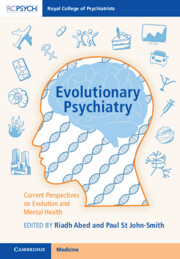Book contents
- Evolutionary Psychiatry
- Reviews
- Evolutionary Psychiatry
- Copyright page
- Contents
- Contributors
- Foreword
- Preface
- Chapter 1 Introduction to Evolutionary Psychiatry
- Chapter 2 The Biopsychosocial Model Advanced by Evolutionary Theory
- Chapter 3 Hominin Evolution I
- Chapter 4 Hominin Evolution II
- Chapter 5 Hunter-Gatherers, Mismatch and Mental Disorder
- Chapter 6 Why Do Mental Disorders Persist?
- Chapter 7 Anxiety Disorders in Evolutionary Perspective
- Chapter 8 Evolutionary Perspectives on Depression
- Chapter 9 On the Randomness of Suicide
- Chapter 10 Evolutionary Perspectives on Schizophrenia Spectrum Disorders
- Chapter 11 Evolutionary Perspectives on Eating Disorders
- Chapter 12 Substance Abuse and Evolution
- Chapter 13 The Social Function of Alcohol from an Evolutionary Perspective
- Chapter 14 Evolutionary Perspectives on Childhood Trauma
- Chapter 15 Evolutionary Perspectives on Neurodevelopmental Disorders
- Chapter 16 Maternal Negativity and Child Maltreatment
- Chapter 17 Alzheimer’s Disease as a Disease of Evolutionary Mismatch, with a Focus on Reproductive Life History
- Chapter 18 Psychopharmacology and Evolution
- Chapter 19 What the Evolutionary and Cognitive Sciences Offer the Sciences of Crime and Justice
- Chapter 20 Evolutionary Thinking and Clinical Care of Psychiatric Patients
- Index
- References
Chapter 2 - The Biopsychosocial Model Advanced by Evolutionary Theory
Published online by Cambridge University Press: 08 September 2022
- Evolutionary Psychiatry
- Reviews
- Evolutionary Psychiatry
- Copyright page
- Contents
- Contributors
- Foreword
- Preface
- Chapter 1 Introduction to Evolutionary Psychiatry
- Chapter 2 The Biopsychosocial Model Advanced by Evolutionary Theory
- Chapter 3 Hominin Evolution I
- Chapter 4 Hominin Evolution II
- Chapter 5 Hunter-Gatherers, Mismatch and Mental Disorder
- Chapter 6 Why Do Mental Disorders Persist?
- Chapter 7 Anxiety Disorders in Evolutionary Perspective
- Chapter 8 Evolutionary Perspectives on Depression
- Chapter 9 On the Randomness of Suicide
- Chapter 10 Evolutionary Perspectives on Schizophrenia Spectrum Disorders
- Chapter 11 Evolutionary Perspectives on Eating Disorders
- Chapter 12 Substance Abuse and Evolution
- Chapter 13 The Social Function of Alcohol from an Evolutionary Perspective
- Chapter 14 Evolutionary Perspectives on Childhood Trauma
- Chapter 15 Evolutionary Perspectives on Neurodevelopmental Disorders
- Chapter 16 Maternal Negativity and Child Maltreatment
- Chapter 17 Alzheimer’s Disease as a Disease of Evolutionary Mismatch, with a Focus on Reproductive Life History
- Chapter 18 Psychopharmacology and Evolution
- Chapter 19 What the Evolutionary and Cognitive Sciences Offer the Sciences of Crime and Justice
- Chapter 20 Evolutionary Thinking and Clinical Care of Psychiatric Patients
- Index
- References
Summary
The currently dominant model of health and disease in psychiatry and medicine is Engel’s biopsychosocial (BPS) model, proposed in the 1970s to advance reductionistic biomedicine by integrating psychological and social factors. Although the BPS model represented progress, its scientific and philosophical foundations remain questionable and it cannot be considered complete or sufficient. In this chapter, we provide a historical and conceptual analysis of the BPS model before showing that the integration of evolutionary theory can provide a suitable next step from the BPS model, much as the BPS model was a step forward from the biomedical approach. Evolutionary theory justifies and enhances the BPS model’s recognition of multiple levels of causation and expands it by recognising both ultimate and proximate causation. It allows a clearer distinction of biological function from dysfunction and encourages a phylogenetic perspective on biology, which can guide research in new directions. In connecting the model of health with the most fundamental theory of biology, this approach provides the philosophical and scientific coherence that the BPS model sorely lacked.
- Type
- Chapter
- Information
- Evolutionary PsychiatryCurrent Perspectives on Evolution and Mental Health, pp. 19 - 34Publisher: Cambridge University PressPrint publication year: 2022
References
- 5
- Cited by

